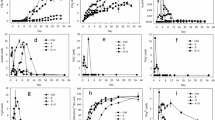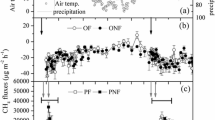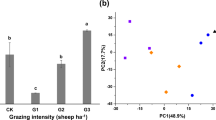Abstract
Methane (CH4) emission is the consequence of CH4 production and consumption performed by methanogens and methanotrophs, respectively. Fertilization is an important factor that regulates the behavior of methanogens and methanotrophs; however, the effect of manure and rice straw addition combined with inorganic fertilizers on these communities is not well understood. This study aimed to explore how manure and rice straw amendments together with inorganic fertilizers influenced the methanogenic and methanotrophic communities in a 31-year fertilized rice paddy. Manure amendment significantly increased the abundance of mcrA and pmoA genes by 61.2% and 63.3% compared with the unfertilized control, whereas inorganic NPK fertilization alone or rice straw addition did not affect their abundances. Manure and rice straw amendments greatly decreased the Shannon index and ACE index of the methanogenic communities, whereas inorganic NPK fertilization alone increased the ACE index of the methanotrophic communities compared with the unfertilized control. Methanosarcinaceae and Methylococcaceae dominated at the family level, representing 23.1–35.0% and 48.7–67.2% of the total reads, for the methanogenic and methanotrophic communities, respectively. Application of manure together with inorganic fertilizers suppressed the Methanocellales methanogens and the type I methanotrophs (Methylococcus and Methylobacter). Fertilization greatly altered the community structure of methanogens and methanotrophs, and manure addition had more apparent effects than rice straw. Moreover, total nitrogen, soil organic carbon, available phosphorus, and available potassium correlated significantly to the abundance, composition, and community structure of methanogens and methanotrophs. In conclusion, our study revealed that long-term manure amendment in combination with inorganic fertilizers significantly increased the abundance of methanogens and methanotrophs, but suppressed the type I methanotrophs in rice paddies.






Similar content being viewed by others
Explore related subjects
Discover the latest articles and news from researchers in related subjects, suggested using machine learning.References
Aguilera J, Motavalli PP, Gonzales MA, Valdivia C (2012) Initial and residual effects of organic and inorganic amendments on soil properties in a potato-based cropping system in the Bolivian Andean highlands. Am J Exp Agr 2(4):641–666
Amaral JA, Knowles R (1995) Growth of methanotrophs in methane and oxygen counter gradients. Microbiol Lett 126(3):215–220
Bao SD (2000) Soil agro-chemistrical analysis, 3rd edn. Beijing, China Agricultural Press
Bao QL, Xiao KQ, Chen Z, Yao HY, Zhu YG (2014) Methane production and methanogenic archaeal communities in two types of paddy soil amended with different amounts of rice straw. FEMS Microb Ecol 88(2):372–385
Bao QL, Huang YZ, Wang FH, Nie SN, Nicol GW, Yao HY, Ding LJ (2016) Effect of nitrogen fertilizer and/or rice straw amendment on methanogenic archaeal communities and methane production from a rice paddy soil. Appl Microbiol Biotechnol 100(13):5989–5998
Bodelier PLE (2015) Bypassing the methane cycle. Nature 523(7652):534–535
Borrel G, Parisot N, Harris HMB, Peyretaillade E, Gaci N, Tottey W, Bardot O, Raymann K, Gribaldo S, Peyret P, O’Toole PW, Brugère JF (2014) Comparative genomics highlights the unique biology of Methanomassiliicoccales, a thermoplasmatales-related seventh order of methanogenic archaea that encodes pyrrolysine. BMC Genomics 15:679
Chauhan A, Pathak A, Ogram A (2012) Composition of methane-oxidizing bacterial communities as a function of nutrient loading in the Florida Everglades. FEMS Microb Ecol 64(3):750–759
Chidthaisong A, Conrad R (2000) Turnover of glucose and acetate coupled to reduction of nitrate, ferric iron and sulfate and to methanogenesis in anoxic rice field soil. FEMS Microb Ecol 31(1):73–86
Conrad R (2007) Microbial ecology of methanogens and methanotrophs. Adv Agron 96:1–63
Conrad R (2009) The global methane cycle: recent advances in understanding the microbial processes involved. Environ Microbiol Rep 1(5):285–292
Conrad R, Klose M (2006) Dynamics of the methanogenic archaeal community in anoxic rice soil upon addition of straw. Eur J Soil Sci 57(4):476–484
Conrad R, Klose M, Noll M (2010) Functional and structural response of the methanogenic microbial community in rice field soil to temperature change. Environ Microbiol 11(7):1844–1853
Core Team R (2014) R: a language and environment for statistical computing. R Foundation for Statistical Computing, Vienna, Austria
Ding WC, Xu XP, He P, Ullah S, Zhang JJ, Cui ZL, Zhou W (2018) Improving yield and nitrogen use efficiency through alternative fertilization options for rice in China: a meta-analysis. Field Crop Res 227:11–18
Dunfield PF, Yuryev A, Senin P, Smirnova AV, Stott MB, Hou S, Ly B, Saw JH, Zhou Z, Ren Y, Wang J, Mountain BW, Crowe MA, Weatherby TM, Bodelier PLE, Liesack W, Feng L, Wang L, Alam M (2007) Methane oxidation by an extremely acidophilic bacterium of the phylum Verrucomicrobia. Nature 450(7171):879–882
Edgar RC (2013) UPARSE: highly accurate OTU sequences from microbial amplicon reads. Nat Methods 10(10):996–998
Edgar RC, Haas BJ, Clemente JC, Quince C, Knight R (2011) UCHIME improves sensitivity and speed of chimera detection. Bioinformatics 27(16):2194–2200
Evans PN, Boyd JA, Leu AO, Woodcroft BJ, Parks DH, Hugenholtz P, Tyson GW (2019) An evolving view of methane metabolism in the Archaea. Nat Rev Microbiol 17(4):219–232
Fadrosh DW, Ma B, Gajer P, Sengamalay N, Ott S, Brotman RM, Ravel J (2014) An improved dual-indexing approach for multiplexed 16S rRNA gene sequencing on the Illumina MiSeq platform. Microbiome 2(1):2–7
FAO (1974) FAO-Unesco soil map of the world, vol VIII. UNESCO, Paris
Fish JA, Chai B, Wang Q, Sun Y, Brown CT, Tiedje JM, Cole JR (2013) FunGene: the functional gene pipeline and repository. Front Microbiol 4:291
Hanson RS, Hanson TE (1996) Methanotrophic bacteria. Microbiol Rev 60(2):439–471
Henckel T, Friedrich M, Conrad R (1999) Molecular analyses of the methane-oxidizing microbial community in rice field soil by targeting the genes of the 16S rRNA, particulate methane monooxygenase, and methanol dehydrogenase. Appl Environ Microbiol 65(5):1980–1990
Ho A, Kerckhof FM, Luke C, Reim A, Krause S, Boon N, Bodelier PLE (2013) Conceptualizing functional traits and ecological characteristics of methane-oxidizing bacteria as life strategies. Environ Microbiol Rep 5(3):335–345
Holmes AJ, Costello A, Lidstrom ME, Murrell JC (1995) Evidence that particulate methane monooxygenase and ammonia monooxygenase may be evolutionarily related. FEMS Microbiol Lett 132(3):203–208
Hu A, Lu YH (2015) The differential effects of ammonium and nitrate on methanotrophs in rice field soil. Soil Biol Biochem 85:31–38
IPCC (2013) Climate change 2013: the physical science basis. Contribution of working group I to the fifth assessment report of the Intergovernmental Panel on Climate Change. Cambridge University Press, Cambridge and New York
Ju XT, Xing GX, Chen XP, Zhang SL, Zhang LJ, Liu XJ, Cui ZL, Yin B, Christie P, Zhu ZL, Zhang FS (2009) Reducing environmental risk by improving N management in intensive Chinese agricultural systems. Proc Natl Acad Sci U S A 106(9):3041–3046
Kim SY, Pramanik P, Bodelier PLE, Kim PJ (2014) Cattle manure enhances methanogens diversity and methane emissions compared to swine manure under rice paddy. PLoS One 9(12):e113593
Kirschke S, Bousquet P, Ciais P, Saunois M, Canadell JG, Dlugokencky EJ, Bergamaschi P, Bergmann D, Blake DR, Bruhwiler L, Cameron-Smith P, Castaldi S, Chevallier F, Feng L, Fraser A, Heimann M, Hodson EL, Houweling S, Josse B, Fraser PJ, Krummel PB, Lamarque J-F, Langenfelds RL, Le Quéré C, Naik V, O’Doherty S, Palmer PI, Pison I, Plummer D, Poulter B, Prinn RG, Rigby M, Ringeval B, Santini M, Schmidt M, Shindell DT, Simpson IJ, Spahni R, Steele LP, Strode SA, Sudo K, Szopa S, van der Werf GR, Voulgarakis A, van Weele M, Weiss RF, Williams JE, Zeng G (2013) Three decades of global methane sources and sinks. Nat Geosci 6(10):813–823
Kong DL, Li SQ, Jin YG, Wu S, Chen J, Hu T, Wang H, Liu SW, Zou JW (2019) Linking methane emissions to methanogenic and methanotrophic communities under different fertilization strategies in rice paddies. Geoderma 347:233–243
Kritee K, Nair D, Zavala-Araiza D, Proville J, Rudek J, Adhya TK, Loecke T, Esteves T, Balireddygari S, Dava O, Ram K, Abhilash SR, Madasamy M, Dokka RV, Anandaraj D, Athiyaman D, Reddy M, Ahuja R, Hamburg SP (2018) High nitrous oxide fluxes from rice indicate the need to manage water for both long- and short-term climate impacts. Proc Natl Acad Sci U S A 115(39):9720–9725
Krüger M, Frenzel P, Kemnitz D, Conrad R (2005) Activity, structure and dynamics of the methanogenic archaeal community in a flooded Italian rice field. FEMS Microb Ecol 51(3):323–331
Le Mer J, Roger P (2001) Production, oxidation, emission and consumption of methane by soils: a review. Eur J Soil Biol 37(1):25–50
Liu SW, Hu ZQ, Wu S, Li SQ, Li ZF, Zou JW (2015) Methane and nitrous oxide emissions reduced following conversion of rice paddies to inland crab-fish aquaculture in Southeast China. Environ Sci Technol 50(2):633–642
Liu HF, Wu X, Li ZS, Wang Q, Liu D, Liu GH (2017) Responses of soil methanogens, methanotrophs, and methane fluxes to land-use conversion and fertilization in a hilly red soil region of southern China. Environ Sci Pollut Res 24(9):8731–8743
Lu YH, Conrad R (2005) In situ stable isotope probing of methanogenic archaea in the rice rhizosphere. Science 309(5737):1088–1090
Lu Y, Fu L, Lu YH, Hugenholtz F, Ma K (2015) Effect of temperature on the structure and activity of a methanogenic archaeal community during rice straw decomposition. Soil Biol Biochem 81:17–27
Lv MR, Li ZP, Che YP, Han FX, Liu M (2011) Soil organic C, nutrients, microbial biomass, and grain yield of rice (Oryza sativa L.) after 18 years of fertilizer application to an infertile paddy soil. Biol Fertil Soils 47(7):777–783
Mohanty SR, Bodelier PLE, Floris V, Conrad R (2006) Differential effects of nitrogenous fertilizers on methane-consuming microbes in rice field and forest soils. Appl Environ Microbiol 72(2):1346–1354
Murrell JC, Jetten MSM (2009) The microbial methane cycle. Environ Microbiol Rep 1(5):279–284
Nazaries L, Karunaratne SB, Delgado-Baquerizo M, Singh BK, Campbell CD (2018) Environmental drivers of the geographical distribution of methanotrophs: insights from a national survey. Soil Biol Biochem 127:264–279
Nyerges G, Stein LY (2010) Ammonia cometabolism and product inhibition vary considerably among species of methanotrophic bacteria. FEMS Microbiol Lett 297(1):131–136
Peng JJ, Lu Z, Rui J, Lu YH (2008) Dynamics of the methanogenic archaeal community during plant residue decomposition in an anoxic rice field soil. Appl Environ Microbiol 74(9):2894–2901
Schloss PD, Gevers D, Westcott SL (2011) Reducing the effects of PCR amplification and sequencing artifacts on 16S rRNA-based studies. PLoS One 6:e27310
Shen JP, Zhang LM, Guo JF, Jessica L, Ray J, He JZ (2010) Impact of long-term fertilization practices on the abundance and composition of soil bacterial communities in Northeast China. Appl Soil Ecol 46(1):119–124
Stein LY, Roy R, Dunfield PF (2012) Aerobic methanotrophy and nitrification: processes and connections. In: Encyclopedia of life sciences (eLS.). Wiley, Chichester, pp 1–11
Steinberg LM, Regan JM (2008) Phylogenetic comparison of the methanogenic communities from an acidic, oligotrophic fen and an anaerobic digester treating municipal wastewater sludge. Appl Environ Microbiol 74(21):6663–6671
Tirol-Padre A, Tsuchiya K, Inubushi K, Ladha JK (2005) Enhancing soil quality through residue management in a rice-wheat system in Fukuoka, Japan. Soil Sci Plant Nutr 51(6):849–860
van Groenigen KJ, Van Kessel C, Hungate BA (2013) Increased greenhouse-gas intensity of rice production under future atmospheric conditions. Nat Clim Chang 3(3):288–291
Wang Q, Garrity GM, Tiedje JM, Cole JR (2007) Naive Bayesian classifier for rapid assignment of rRNA sequences into the new bacterial taxonomy. Appl Environ Microbiol 73(16):5261–5267
Wu LQ, Ma K, Li Q, Ke XB, Lu YH (2009) Composition of archaeal community in a paddy field as affected by rice cultivar and N fertilizer. Microb Ecol 58(4):819–826
Yang YD, Wang PX, Zeng ZH (2019) Dynamics of bacterial communities in a 30-year fertilized paddy field under different organic-inorganic fertilization strategies. Agronomy 9(1):14
Yuan J, Yuan YK, Zhu YH, Cao LK (2018) Effects of different fertilizers on methane emissions and methanogenic community structures in paddy rhizosphere soil. Sci Total Environ 627:770–781
Zhang JW, Tang HY, Zhu JG, Lin XG, Feng YZ (2016) Divergent responses of methanogenic archaeal communities in two rice cultivars to elevated ground-level O3. Environ Pollut 213:127–134
Zhang WZ, Sheng R, Zhang MM, Xiong GY, Hou HJ, Li SL, Wei WX (2018) Effects of continuous manure application on methanogenic and methanotrophic communities and methane production potentials in rice paddy soil. Agric Ecosyst Environ 258:121–128
Zheng Y, Zhang LM, Zheng YM, Di HJ, He JZ (2008) Abundance and community composition of methanotrophs in a Chinese paddy soil under long-term fertilization practices. J Soils Sediments 8(6):406–414
Zheng Y, Zhang LM, He JZ (2013) Immediate effects of nitrogen, phosphorus, and potassium amendments on the methanotrophic activity and abundance in a Chinese paddy soil under short-term incubation experiment. J Soils Sediments 13(1):189–196
Acknowledgments
Special thanks go to the anonymous reviewers for their constructive comments in improving this manuscript.
Funding
This work was supported by the National Key Research and Development Program of China (2016YFD0300205-01), the National Natural Science Foundation of China (31671640), and the China Postdoctoral Science Foundation Funded Project (2018M641540).
Author information
Authors and Affiliations
Corresponding author
Additional information
Responsible editor: Diane Purchase
Publisher’s note
Springer Nature remains neutral with regard to jurisdictional claims in published maps and institutional affiliations.
Rights and permissions
About this article
Cite this article
Wang, PX., Yang, YD., Wang, XQ. et al. Manure amendment increased the abundance of methanogens and methanotrophs but suppressed the type I methanotrophs in rice paddies. Environ Sci Pollut Res 27, 8016–8027 (2020). https://doi.org/10.1007/s11356-019-07464-1
Received:
Accepted:
Published:
Issue Date:
DOI: https://doi.org/10.1007/s11356-019-07464-1
Keywords
Profiles
- Leanne Peixoto View author profile




